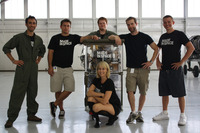 Space.com reports this morning on experiments undertaken by Made In Space to verify whether 3D printers can be used in orbit. Evidently two commercial 3D printers were tested during temporary zero-gravity environment simulation fights.
Space.com reports this morning on experiments undertaken by Made In Space to verify whether 3D printers can be used in orbit. Evidently two commercial 3D printers were tested during temporary zero-gravity environment simulation fights.We’ve written about Made In Space before, as they were formed last year to address the problem of efficiently solving the problem of spare parts in orbit. The group was founded by students from the Singularity University and now their product has passed the zero-gravity test.
Space 3D printing is an obvious application, since it would vastly simplify the need for spare parts. Instead of shipping a heavy inventory of parts ahead of time, most of which would probably never be needed, you need only send a 3D printer and some print material. Then parts are made only as required.
The 3D printers tested by Made In Space were not specified in the report, but apparently one of the modified 3D printers came from industry giant 3D Systems. In the image (click the Made In Space team’s pic above for larger detail), it’s unclear which models are in play. However, there seems to be very significant modifications present.
We suspect the modifications may involve a number of different areas:
- One of the most important areas will be fume capture. Unpleasant, if not toxic fumes are sometimes produced by 3D printers, depending on what you’re using as raw material. You don’t want to pollute the closed environment of a human-occupied spacecraft.
- Another area of interest would be waste capture, since many 3D printers issue dust, drips or fine bits that would no doubt disrupt or even damage a spacecraft as they float freely about the cabin in a micro-gravity environment.
- Safety concerns will be high, as some types of 3D printers have components that operate at very high temperatures and even high voltages. Orbital 3D printers would have to protect against heat damage by including physical or electrical safety measures.
- Function of the 3D printers in zero-gravity would have to be ensured. The right materials should still adhere even though no gravity would push layers together.
- Object finishing is often a dirty process, sometimes involving vacuum chambers or very sharp implements. Dangerous stuff for an orbital human environment.
And there’s no doubt many more concerns that Made In Space must address. Nevertheless, this is a huge development that will make future space journeys, especially long term journeys, a lot simpler.
Via Space.com


So run it outside.